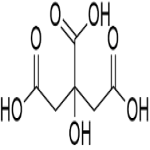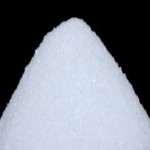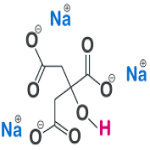Citric Acid Monohydrate Anhydrous n Sodium Citrate Anhydrous Dihydrate BP Ph Eur USP FCC Reagent Food Grade Suppliers Exporters, Manufacturers
Citric Acid
CAS Number: 5949-29-1 & 77-92-9 Monohydrate Anhydrous BP Ph Eur USP FCC Reagent Food Grade Suppliers Exporters, Manufacturers
Please visit Safety Data Sheet of Citric Acid Monohydrate Anhydrous BP Ph Eur USP FCC Reagent Food Grade Manufacturers.
Anhydrous Citric Acid USP Grade Specifications:
C6H8O7 --- 192.1
1,2,3-Propanetricarboxylic acid, 2-hydroxy-;
Citric acid CAS 77-92-9
DEFINITION
Anhydrous Citric Acid contains NLT 99.5% and NMT 100.5% of C6H8O7, calculated on the anhydrous basis.
IDENTIFICATION
A. Infrared Absorption: Dry the substance to be examined at 105C for 2 h.
ASSAY
Procedure
Sample: 0.550 g of Anhydrous Citric Acid; record weight accurately.
Analysis: Dissolve the Sample in 50 mL of water. Add 0.5 mL of phenolphthalein TS. Titrate with 1 N sodium hydroxide VS. Each mL of 1 N sodium hydroxide is equivalent to 64.03 mg of C6H8O7.
Acceptance criteria: 99.5% to 100.5% on the anhydrous basis.
Residue on Ignition: NMT 0.1%, determined on 1.0 g
Sulfate: To pass the test. --- (0.015%).
Limit of Aluminum (where it is labeled as intended for use in dialysis): To pass the test. --- (0.2 ppm).
Limit of Oxalic Acid: To pass the test.
Bacterial Endotoxins Test: The level of bacterial endotoxins is such that the requirement in the relevant dosage form monograph(s) in which Anhydrous Citric Acid is used can be met. Where the label states that Anhydrous & Citric Acid must be subjected to further processing during the preparation of injectable dosage forms, the level of bacterial endotoxins is such that the requirement in the relevant dosage form monograph(s) in which Anhydrous Citric Acid is used can be met.
Clarity of Solution: To pass the test.
Color of Solution: To pass the test.
Readily Carbonizable Substances:
Sample: 1.0 g of powdered Anhydrous Citric Acid
Analysis: Transfer the Sample to a 22-mm x 175-mm test tube previously rinsed with 10 mL of sulfuric acid and allowed to drain for 10 min. Add 10 mL of sulfuric acid, agitate until solution is complete, and immerse in a water bath at 90±1C for 60±0.5 min, keeping the level of the acid below the level of the water during the entire period. Cool the tube in running water and transfer the acid to a color-comparison tube.
Acceptance criteria: The color of the acid is not darker than that of a similar volume of Matching Fluid K in a matching tube, the tubes being observed vertically against a white background.
Sterility Tests: Where the label states that Anhydrous Citric Acid is sterile, it meets the requirements for Sterility Tests in the relevant dosage form monograph(s) in which Anhydrous Citric Acid is used.
Water Determination:
Sample: 2.0 g of Anhydrous Citric Acid
Acceptance criteria: NMT 1.0%
Packaging and Storage: Preserve in tight containers. No storage requirements specified.
Citric Acid Monohydrate USP Grade Specifications:
C6H8O7-H2O --- 210.14
1,2,3-Propanetricarboxylic acid, 2-hydroxy-, monohydrate CAS 5949-29-1
DEFINITION
Citric Acid Monohydrate contains one molecule of water of hydration. It contains NLT 99.5% and NMT 100.5% of C6H8O7, calculated on the anhydrous basis.
IDENTIFICATION
A. Infrared Absorption: Dry the substance to be examined at 105C for 2 h.
ASSAY
Procedure
Sample: 0.550 g of Citric Acid Monohydrate. Record the weight accurately.
Analysis: Dissolve the Sample in 50 mL of water and add 0.5 mL of phenolphthalein. Titrate with 1 N sodium hydroxide. Each mL of 1 N sodium hydroxide is equivalent to 64.03 mg of C6H8O7.
Acceptance criteria: 99.5% to 100.5% on the anhydrous basis.
Sulfate: To pass the test. --- (0.015%).
Limit of Aluminum (where it is labeled as intended for use in dialysis): To pass the test. --- (0.2 ppm).
Limit of Oxalic Acid: To pass the test. --- (0.036%).
Bacterial Endotoxins Test: The level of bacterial endotoxins is such that the requirement in the relevant dosage form monograph(s) in which Citric Acid Monohydrate is used can be met. Where the label states that Citric Acid Monohydrate must be subjected to further processing during the preparation of injectable dosage forms, the level of bacterial endotoxins is such that the requirement in the relevant dosage form monograph(s) in which Citric Acid Monohydrate is used can be met.
Clarity of Solution: To pass the test.
Color of Solution: To pass the test.
Readily Carbonizable Substances:
Sample: 1.0 g powdered Citric Acid Monohydrate
Analysis: Transfer th Sample to a 22-mm x 175-mm test tube previously rinsed with 10 mL of sulfuric acid and allowed to drain for 10 min. Add 10 mL of sulfuric acid, agitate until solution is complete, and immerse in a water bath at 90±1C for 60±0.5 min, keeping the level of the acid below the level of the water during the entire period. Cool the tube in running water and transfer the acid to a color-comparison tube.
Acceptance criteria: The color of the acid is not darker than that of a similar volume of Matching Fluid K in a matching tube, the tubes being observed vertically against a white background.
Sterility Tests: Where the label states that Citric Acid Monohydrate is sterile, it meets the requirements for Sterility Tests in the relevant dosage form monograph(s) in which Citric Acid Monohydrate is used.
Water Determination:
Sample: 0.5 g of Citric Acid Monohydrate
Acceptance criteria: 7.5% to 9.0%
Packaging and Storage: Preserve in tight containers. No storage requirements specified.
Specifications of Citric Acid Monohydrate BP Ph Eur Grade
C6H8O7-H2O -- 210 -- CAS 5949-29-1
Citric Acid BP Monohydrate
DEFINITION
2-Hydroxypropane-1,2,3-tricarboxylic acid monohydrate.
Content: 99.5 per cent to 100.5 per cent (anhydrous substance).
CHARACTERS
Appearance: White or almost white, crystalline powder, colourless crystals or granules, efflorescent.
Solubility: Very soluble in water, freely soluble in ethanol (96 per cent).
IDENTIFICATION
First identification B, E.
Second identification A, C, D, E.
A. Dissolve 1 g in 10 ml of water. The solution is strongly acidic.
B. Infrared absorption spectrophotometry.
C. Add about 5 mg to a mixture of 1 ml of acetic anhydride and 3 ml of pyridine. A red colour develops.
D. Dissolve 0.5 g in 5 ml of water, neutralize using 1 M sodium hydroxide (about 7 ml), add 10 ml of calcium chloride solution R and heat to boiling. A white precipitate is formed.
E. Water (see Tests).
TESTS
Appearance of solution: The solution is clear and not more intensely coloured than reference.
Dissolve 2.0 g in water and dilute to 10 ml with the same solvent.
Readily carbonizable substances: To 1.0 g in a cleaned test tube add 10 ml of sulphuric acid and immediately heat the mixture in a water-bath at 90±1C for 60 min. Cool rapidly immediately afterwards. The solution is not more intensely coloured than a mixture of 1 ml of red primary solution and 9 ml of yellow primary solution.
Oxalic acid: Maximum 360 ppm, calculated as anhydrous oxalic acid.
Sulphates: Maximum 150 ppm.
Aluminium: Maximum 0.2 ppm, if intended for use in the manufacture of dialysis solutions.
Heavy metals: Maximum 10 ppm.
Water: 7.5 per cent to 9.0 per cent, determined on 0.500 g.
Sulphated ash: Maximum 0.1 per cent, determined on 1.0 g.
Bacterial endotoxins: Less than 0.5 IU/mg, if intended for use in the manufacture of parenteral dosage forms without a further appropriate procedure for the removal of bacterial endotoxins.
Specifications of Citric Acid FCC Food Grade
C6H8O7 Formula wt, anhydrous 192.13
C6H8O7-H2O Formula wt, monohydrate 210.14
INS: 330 CAS: anhydrous 77-92-9
CAS: monohydrate 5949-29-1
DESCRIPTION
Citric Acid occurs as colorless, translucent crystals or as a white, granular to fine, crystalline powder. It is anhydrous or contains one molecule of water of hydration. The hydrous form is efflorescent in dry air. It is odorless and has a strongly acid taste. One gram is soluble in about 0.5 mL of water, in about 2 mL of alcohol, and in about 30 mL of ether.
Function: Sequestrant; dispersing agent; acidifier; flavoring agent.
REQUIREMENTS
Labeling: Indicate whether it is anhydrous or hydrous.
Identification: A 1:10 aqueous solution gives positive tests for Citrate.
Assay: Not less than 99.5% and not more than 100.5% of C6H8O7, calculated on the anhydrous basis.
Lead: Not more than 0.5 mg/kg.
Oxalate: Passes test.
Readily Carbonizable: Substances Passes test.
Residue on Ignition: Not more than 0.05%.
Tridodecylamine (for solvent-extracted Citric Acid only): Not more than 0.1 mg/kg.
Water: Anhydrous: Not more than 0.5%; Monohydrate: Not more than 8.8%.
Specifications of Citric Acid Analytical Reagent
Citric Acid, Anhydrous, and Citric Acid, Monohydrate
2-Hydroxy-1,2,3-propanetricarboxylic Acid
HOCOCH2C(OH)(COOH)CH2COOH; Formula Wt. 192.13
HOCOCH2C(OH)(COOH)CH2COOH-H2O; Formula Wt. 210.14
CAS Number 77-92-9 (Anhydrous); 5949-29-1 (Monohydrate)
REQUIREMENTS
Assay: 99.5% C6H8O7; 99.0-102.0% C6H8O7-H2O min
MAXIMUM ALLOWABLE
Insoluble matter: 0.005%
Residue after ignition: 0.02%
Chloride (Cl): 0.001%
Oxalate (C2O4): Passes test
Phosphate (PO4): 0.001%
Sulfate (SO4): 0.002%
Iron (Fe): 3 ppm
Lead (Pb): 2 ppm
Substances carbonizable by hot sulfuric acid: Passes test.

Please visit Hazard Statement of Citric Acid Monohydrate Anhydrous BP Ph Eur USP FCC Reagent Food Grade Suppliers.
Sodium Citrate
CAS Number: 68-04-2 or 6132-04-3 BP Ph Eur USP FCC Food Grade Suppliers Exporters, Manufacturers

Please visit Safety Data Sheet of Sodium Citrate BP Ph Eur USP FCC Food Grade Manufacturers.
Specifications of Sodium Citrate BP Grade Ph Eur Grade
Trisodium Citrate Ph Eur.
C6H5Na3O7,2H2O -- 294.1 -- CAS 6132-04-3
DEFINITION
Trisodium 2-hydroxypropane-1,2,3-tricarboxylate dihydrate.
Content: 99.0 per cent to 101.0 per cent (anhydrous substance).
CHARACTERS
Appearance: White or almost white, crystalline powder or white or almost white, granular crystals, slightly deliquescent in moist air.
Solubility: Freely soluble in water, practically insoluble in ethanol (96 per cent).
IDENTIFICATION
A. To 1 ml of solution S (see Tests) add 4 ml of water. The solution gives the reaction of citrates.
B. 1 ml of solution S gives reaction of sodium.
TESTS
Solution S: Dissolve 10.0 g in carbon dioxide-free water R prepared from distilled water R and dilute to 100 ml with the same solvent.
Appearance of solution: Solution S is clear and colourless.
Acidity or alkalinity: To 10 ml of solution S add 0.1 ml of PhPh solution. Not more than 0.2 ml of 0.1M hydrochloric acid or 0.1 M sodium hydroxide is required to change the colour of the indicator.
Readily carbonizable substances: To 0.20 g of the powdered substance to be examined add 10 ml of sulphuric acid and heat in a water-bath at 90 ± 1 °C for 60 min. Cool rapidly. The solution is not more intensely coloured than reference solution.
Chlorides: Maximum 50 ppm.
Oxalates: Maximum 300 ppm.
Sulphates: Maximum 150 ppm.
Heavy metals: Maximum 10 ppm.
Water: 11.0 per cent to 13.0 per cent, determined on 0.300 g. After adding the substance to be examined, stir for 15 min before titrating.
Sodium Citrate IP Grade
We also make IP grade of Sodium Citrate
Specifications of Sodium Citrate USP
C6H5Na3O7 (anhydrous) 258.07
1,2,3-Propanetricarboxylic acid, 2-hydroxy-, trisodium salt.
Trisodium citrate (anhydrous) CAS 68-04-2]
Trisodium citrate dihydrate 294.10 CAS 6132-04-3
Sodium Citrate is anhydrous or contains two molecules of water of hydration. It contains not less than 99.0 percent and not more than 100.5 percent of C6H5Na3O7, calculated on the anhydrous basis.
Identification:
A: A solution (1 in 20) responds to the tests for Sodium and for Citrate.
B: Upon ignition, it yields an alkaline residue which effervesces when treated with 3 N hydrochloric acid.
Alkalinity: A solution of 1.0 g in 20 mL of water is alkaline to litmus paper, but after the addition of 0.20 mL of 0.10 N sulfuric acid no pink color is produced by 1 drop of PhPh.
Water: Dry it at 180 for 18 hours: the anhydrous form loses not more than 1.0%, and the hydrous form between 10.0% and 13.0%, of its weight.
Tartrate: the limit is 0.001%.
Specifications of Sodium Citrate FCC Food Grade
Trisodium Citrate
C6H5Na3O7 Formula weight, anhydrous 258.07
C6H5Na3O7-2H2O Formula weight, dihydrate 294.10
INS: 331(iii) CAS: anhydrous 68-04-2
CAS: dihydrate 6132-04-3
DESCRIPTION
Sodium Citrate occurs as colorless crystals or as a white, crystalline powder. It is anhydrous or contains two molecules of water of crystallization. One gram of the dihydrate dissolves in 1.5 mL of water at 25C and in 0.6 mL of boiling water. It is insoluble in alcohol.
REQUIREMENTS
Identification: A 1:20 aqueous solution gives positive tests for Sodium and for Citrate.
Assay: Not less than 99.0% and not more than 100.5% of C6H5Na3O7, calculated on the anhydrous basis.
Alkalinity: Passes test.
Lead: Not more than 2 mg/kg.
Water: Anhydrous: Not more than 1%; Dihydrate: Between 10.0% and 13.0%.
Sodium Citrate Anhydrous is offered with very low moisture content.

Please visit Hazard Statement of Sodium Citrate BP Ph Eur USP FCC Food Grade Suppliers.
Citric Acid CAS Number 5949-29-1 & 77-92-9 & Sodium Citrate CAS Number 68-04-2 or 6132-04-3 Supplier Exporter, Manufacturer:
Annie Chemie P Ltd
Mumbai 4000010, INDIA
With Agents and offices in UAE, USA, Europe.
e-mail: info@anniechemie.com
Copyright and Usual Disclaimer is Applicable.
May 31, 2025
Exporters to USA, Canada, UK, Europe, UAE, Nigeria, Algeria, Turkey, Mexico, Brazil, Chile, Argentina, Australia, Dubai etc.
Perfection is made up of small things and that is a big thing.
